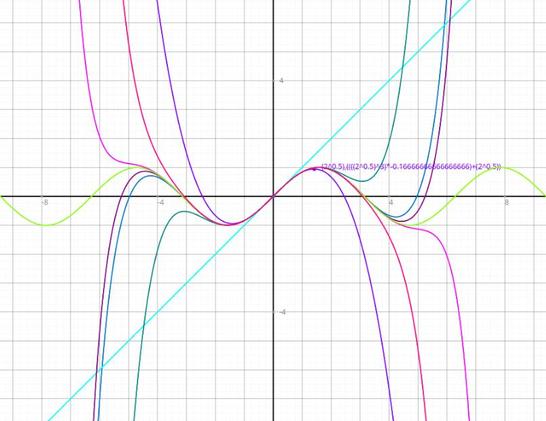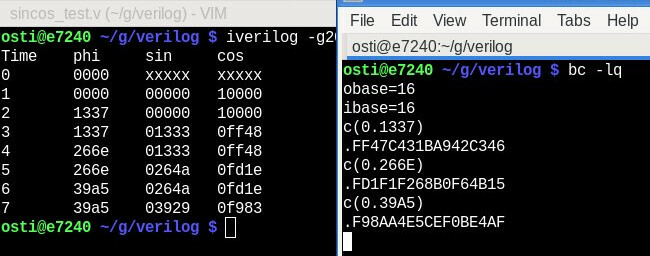Day 24 of Ayliean's @ayliean.bsky.social
#MathArtMarch thread
Two pairs of #equal #equations:
y=sin(x) equals y=x-x³/3!+x⁵/5!-...+x^(2n-1)/(2n-1)!
y=cos(x) equals y=1-x²/2!+x⁴-...+x^(2n)/2n!
See ALT, please!
#mathematics #trigonometry #sine #cosine #Taylorseries #Taylorexpansion #Euleridentity
RE: https://bsky.app/profile/did:plc:enw4w6ihzt4uomkphuxuvczu/post/3lje6cgmacs2u
#cosine
Innovative Dutch Technology Captures Historic Image of Mars and Deimos During ESA’s Hera Mission flyby
Day 13 of #MathArtMarch 13th: #zero
e^ipi+1=0
I made this visualization of the famous #Euleridentity with this ingenious toy: www.matheretter.de/rechner/gfplot
#sharingisthenewlearning #SharingIsCaring #mathematics #sine #cosine
RE: https://bsky.app/profile/did:plc:enw4w6ihzt4uomkphuxuvczu/post/3lje6cgmacs2u
Let’s celebrate the legacy of this mathematical giant together! 💬👇
#LeonhardEuler #Trigonometry #Mathematics #History #STEM #Innovation #Russia #Sine #Cosine #EulerFormula
Thrilled to get certified on Redis AI today, great course and certification on #Hash #JSON #VectorSeach #VectorSimilaritySearch #RedisVL #Enclidean #Cosine #IP #HNSW #FLAT. For Unstructured data (PDF, Docx, xlsx, etc…) It is extremely fast. #SemanticCaching #RedisMemory
Of course, I give "cossin" to my search engine, and it immediately thinks I'm searching for "cosine."
😩
Sin ? yes, sin and cosin (Sine & Cosine) are most understandable from mathematician, soft or hardware engineer to all forms of logical thinking professional field, once sin and cosin have been discussed and learned frequently, a society will logical became much more reasonable and knowledgeable to the universe which is full of knowledge for us to discover.
Kaze Emanuar’s Adventures in Mario 64 Optimization: Calculating Sine
I've mentioned Kaze Emanuar's efforts to make the best Mario 64 there can possibly be on its native hardware. He's compiled it with optimization flags turne
https://setsideb.com/kaze-emanuars-adventures-in-mario-64-optimization-calculating-sine/
#development #niche #retro #cosine #development #kazeemanuar #mario #mario64 #math #n64 #niche #nintendo #optimization #retro #sine #taylorseries #trigonometry #video #youtube
Semantic search with cosine similarity. Models from huggingface.co are really nice to work with.
https://owehrens.com/semantic-search-with-cosine-similarity/ #cosine #semanticsearch @huggingface
Been a week since #COSine 2023 and I am mostly recovered! @marthawells was a fantastic guest (really nice and really smart) and I _think_ we may have broken our all-time attendance record!
HOW SINES AND COSINES WORK
#Trig #Trigonometry #Sine #Cosine
You have understood sines and cosines since you were two years old; you just didn't know the terminology.
Let us start with a diagonal line; a slash will do:
/
Now, do you agree that the line travels up and to the right? (Of course you do.) Do you also have a sense that the amount of "up" and the amount of "right" is related to the angle? (I imagine you do.)
The "sine" is just how much "up" you get with a given angle. and the "cosine" is how much "right" you get with an angle. Sines and cosines range from -1 to 1; when they're negative, you can think of them as "down" and "left" respectively.
That's all sine and cosine are: they tell you how far vertically and horizontally you go for a given angle. And as promised, you knew that even as a toddler: steep angles go up a lot, gentle slopes do not.
You can also think of sines and cosines as percents, that go from -100% to 100%. People don't do that in common practice, but you can think in those terms if it makes things feel more right. For example, the sine of a 30-degree angle is 0.5, OR you can think of it as 50%. So if you draw a 10 inch line at a 30 degree angle, that line will end up 5 inches up from where you started: 50% of 10 inches is 5 inches.
Nice little adventure, but having limited precision can lead to more accumulated errors in your calculations 😬:
“Implementing Cosine In C From Scratch” [2020], Austin Henley (https://austinhenley.com/blog/cosine.html).
Extreme Espresso, Part 2: An Inductive Water Level Sensor
[Mark Smith] must really, really like his coffee, at least judging by how much effort he's put into tricking out his espresso machine.
This inductive water tank sensor is part of a series of innovations [Mark] has added to his high-end Rancilio Silvia machine -- we assume there are those that would quibble with that characterization, but 800 bucks is a lot to spend for a coffee maker in our books. We recently featured a host of mods he made to the machine as part of the "Espresso Connect" project, which includes a cool Nixie tube bar graph to indicate the water level in the machine. That display is driven by this sensor, the details of which [Mark] has now shared. The sensor straddles the wall of the 1.7-liter water tank, so no penetrations are needed. Inside the tanks is a track that guides a copper and PETG float that's sealed with food-safe epoxy resin.
Directly adjacent to the float track on the outside of the tank is a long PCB with a couple of long, sinuous traces. These connect to an LX3302A inductive sensor IC, which reads the position of the copper slug inside the float. That simplifies the process greatly; [Mark] goes into great detail about the design and calibration of the sensor board, as well as hooking it into the Raspberry Pi Zero that lies at the heart of "Espresso Connect'. Altogether, the mods make for a precisely measured dose of espresso, as seen in the video below.
We'd say this was maybe a bit far to go for the perfect cup of coffee, but we sure respect the effort. And we think this inductive sensor method has a lot of non-caffeinated applications that probably bear exploration.
#cookinghacks #coffee #cosine #epoxy #espresso #inductive #linear #liquidlevel #lx3320a #raspberrypizero #sine






![Screenshot of verilog source code.
Left: sincos.v
module main (
input [15:0] in,
output reg [16:0] sin,
output reg [16:0] cos
);
function [16:0] sin3(input [15:0] phi);
reg [31:0] phi3;
phi3 = (((phi*phi)>>16)*phi)>>16;
sin3 = phi-(phi3/6);
endfunction
function [16:0] cos2(input [15:0] phi);
reg [31:0] phi2;
phi2 = (phi*phi)>>16;
cos2 = (1 << 16) - (phi2>>1);
endfunction
always @(in) begin
sin = sin3(in);
cos = cos2(in);
end
endmodule
Right: sincos_test.v
module main (
input [15:0] in,
output reg [16:0] sin,
output reg [16:0] cos
);
function [16:0] sin3(input [15:0] phi);
reg [31:0] phi3;
phi3 = (((phi*phi)>>16)*phi)>>16;
sin3 = phi-(phi3/6);
endfunction
function [16:0] cos2(input [15:0] phi);
reg [31:0] phi2;
phi2 = (phi*phi)>>16;
cos2 = (1 << 16) - (phi2>>1);
endfunction
always @(in) begin
sin = sin3(in);
cos = cos2(in);
end
endmodule](https://files.mastodon.social/cache/media_attachments/files/111/658/310/232/869/476/small/34eeaef6f9e647b7.jpg)
